Students do so much sitting in a day. During a very long professional development, my principal looked at her watch and said, “We have just hit 75 minutes — the length of a class period.” I was shocked at how much my body just wanted to escape my chair for a walk or a stretch break.
According to the U.S. Department of Health and Human Services, “Movement increases the heart rate and stimulates brain function, which facilitates a child’s ability to learn,” so here are three “Get Up and Move” activities that I implemented in my classroom.
[Note: Some of these activities are included in Maneuvering the Middle’s All Access subscription or can be purchased here, but I am going to explain how you might prepare for and execute these activities if you are not a middle school math teacher.]
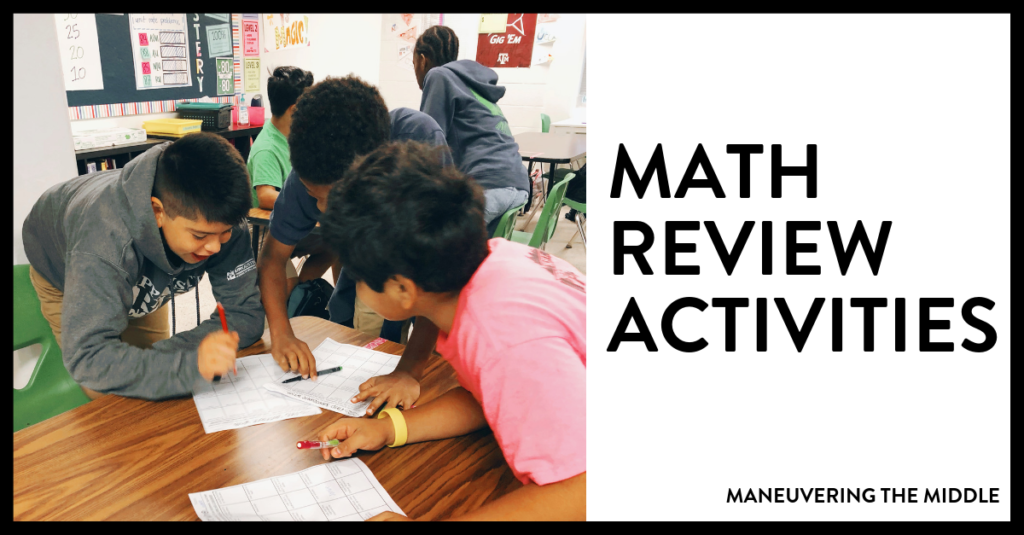
Math Review Game: FLYSWATTER
The flyswatter game was around when I was a student – I remember playing it in my Spanish class! Students love this game, and they ask for it daily. Since it is a very low lift, I would use it as an incentive for finished work.
PLANNING
Project around 10 answers on the board. (I don’t recommend writing the answers on the whiteboard with dry erase markers because they will get rubbed off.) You need two flyswatters. Tape a line on the floor parallel to the board, about five feet from the board. This is where students will stop to hear their problem.
The flyswatter game works with problems that are fluency-based. We are going for speed here. Here is a suggestion: fraction, decimal, and percent equivalents. You could project these answers: 40%, 25%, 0.6, ½, etc…
EXECUTION
Divide students into two groups. Boys versus girls is my go-to. They should be in 2 lines facing the board. Set the expectation that you will not call out a problem until it is silent. When the first two opponents are up, you could say, “Two fifths!” The student who hit 40% first would win and stay in the game, and the other student would take a seat. The fly swatters are passed on. The winner would go to the back of the line, and the next two students would be up. You keep playing until there is one player left.
Math Review Game: SCAVENGER HUNT
This is by far my favorite activity. You can read more details on how to execute a scavenger hunt in this post. It’s self-checking, and you could pull or work with a small group during this activity.
-
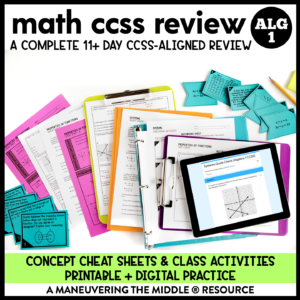 Algebra 1 Review and Test Prep CCSS
Algebra 1 Review and Test Prep CCSS -
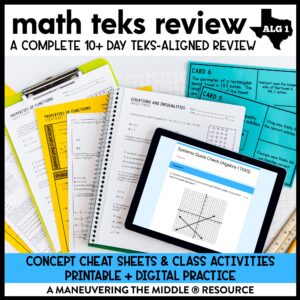 Algebra 1 Review and Test Prep TEKS
Algebra 1 Review and Test Prep TEKS -
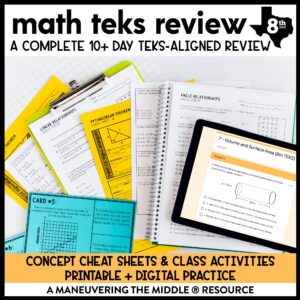 8th Grade Math Review and Test Prep TEKS
8th Grade Math Review and Test Prep TEKS -
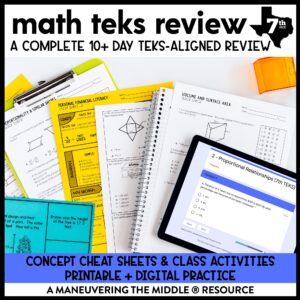 7th Grade Math Review and Test Prep TEKS
7th Grade Math Review and Test Prep TEKS -
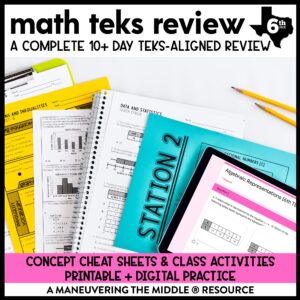 6th Grade Math Review and Test Prep Unit TEKS
6th Grade Math Review and Test Prep Unit TEKS -
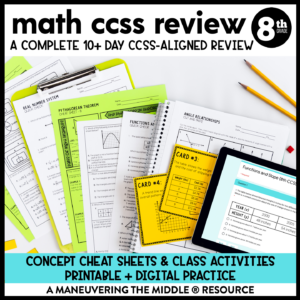 8th Grade Math Review and Test Prep Unit CCSS
8th Grade Math Review and Test Prep Unit CCSS -
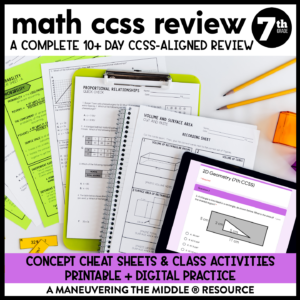 7th Grade Math Review and Test Prep CCSS
7th Grade Math Review and Test Prep CCSS -
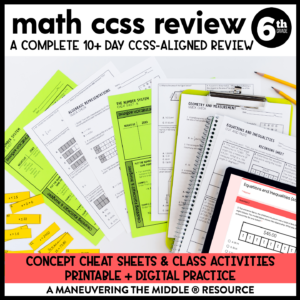 6th Grade Math Review and Test Prep Unit CCSS
6th Grade Math Review and Test Prep Unit CCSS
MATH REVIEW GAME: Cake Walk
PLANNING
Similar to a cake walk, students will be up and walking in a circle, so consider that when arranging desks/chairs and/or giving directions for how you want them to walk. I had tables and would push them to the side of the room and arrange chairs in a large circle. Each chair needs to be numbered.
Have your problems ready on a slideshow. Students will need scratch paper and a clipboard to write on.
EXECUTION
Play music while students walk around the chairs. Stop the music, students sit, and you project a problem. Students then work on the problem. Use a random number generator to pick the chair number. The student sitting in that chair gets a prize (could be bonus points on a test, free homework pass, sticker, piece of candy) if their work is correct. This activity is great for review before a unit test!
If you don’t have time to plan something special for students to get out of their seats, but you can feel the restlessness in the classroom, then you can still have students get up and move! You can have students find a partner, work out a problem, and then move to find a new partner for the next problem.
Math Concepts for Kinesthetic Learning
These concepts are perfect for students to use their body to act out. If you have more ideas, please comment below!
- Positive slope, negative slope, undefined, zero
- Angles – acute, obtuse, 90 degrees, 180 degrees
- Transformations – translate (slide), rotations, reflections, dilations (greater than 1? Act out e x p a n d i n g, less than 1? Act out shrinking)
- Adding and subtracting decimals (act out lining up your buttons on a shirt with lining up decimals for adding and subtracting)
- Coordinate plane (body is the y axis, arms are the x axis, negative space creates the quadrants)
- Inequalities – arms for the greater than and less than signs
- Types of Functions – linear, U for quadratic, and exponential
- Parallel and perpendicular lines
- Types of solutions – arms crossed for one solution, parallel arms for no solution, and arms on top of each other for infinite solutions)
How do you get students moving in your classroom?
Check out this related post: Turn Any Worksheet Into a Math Activity
Maneuvering the Middle has been writing and publishing blog posts for almost a decade! This post was originally published in 2016 and has been updated for clarity and relevance.
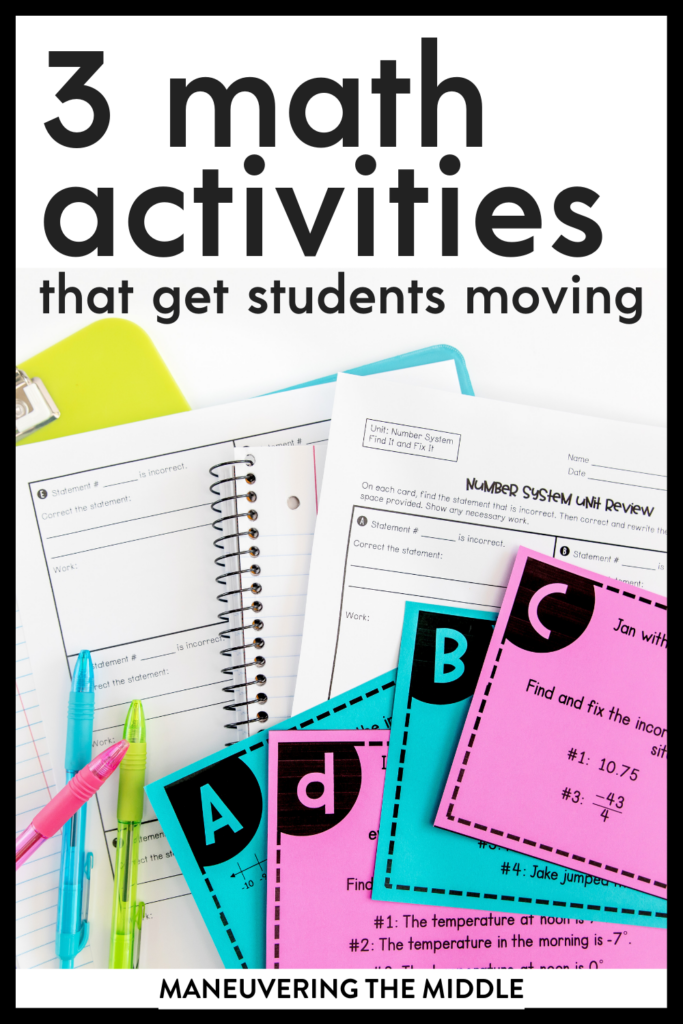
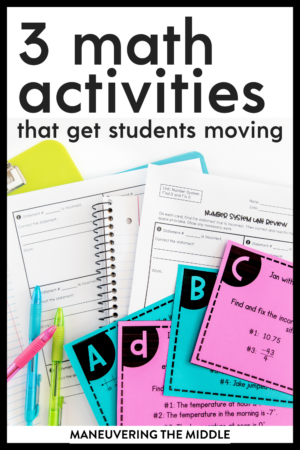

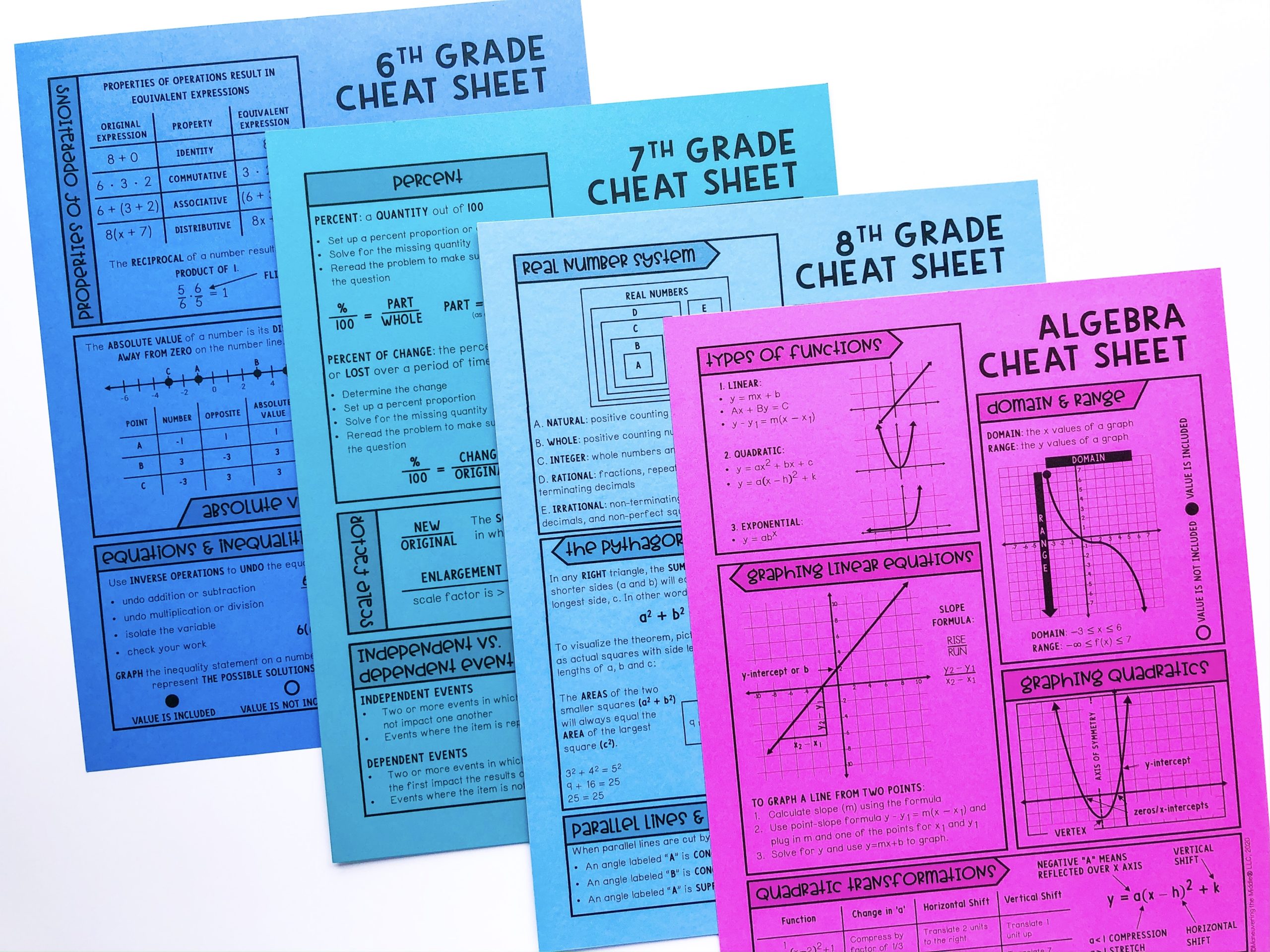
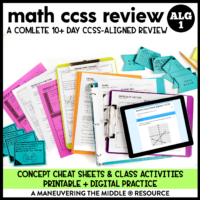
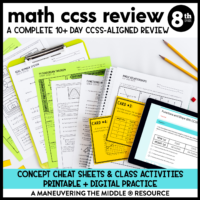
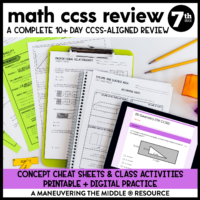
We also love Scavenger Hunts! If you’re careful not to duplicate answers, you can also have two or three "levels" of Scavenger Hunts going at the same time! I’ve also been creating games called Whodunnit based on a review game I tried once from Teachers Pay Teachers. We enjoy two twists on Jeopardy style games called Star Wars and a vocab-based game called Password. We also like to do stations.
Yes, great ideas Abigail! I will have to look up Whodunnit, that is a new one for me. Anything to keep students working, learning, and having fun! Makes for a much easier day.
I tried Speed Dating with my students once this past year and the kids loved it! It’s an activity that you need to give a bit of time to during class so that students have adequate time to become “experts” at their problem. But there is a lot of opportunity for differentiation and confidence building! Scavenger hunts are my favorite. Students really get into trying to figure out the correct order of all the cards. And it’s a great activity to have the class work on while you work with small groups!
Oh yay! I am glad you had such a great experience with Speed Dating! It can get a little noisy! 😉 And yes, perfect idea for the class to be working on scavenger hunts while you pull a small group.
We love scavenger hunts too! Another favorite is mad lib…each problem has four answer choices with a word next to each. Once they complete the problem, they find the word next to the correct answer and put it in their mad lib story. Some of our stories get a little crazy but the kids love it! And for the faster problems, I often use Kahoot! We do lots of activities and games in my math class to keep the kids interested.
Speed Dating and Scavenger hunts are a big heck yes. I also just do straight up task cards without the loop, and I get pretty creative with how I hide them. Sometimes if my kids have been really awesome I hide them in our hallway and it becomes an Out in the World scavenger hunt. They love it!
Another favorite is Secret Word Vocab Review. Kind of like task cards or a scavenger hunt with vocab terms, and for each problem, I give them a clue to circle a particular letter in their answer. At the end, they unscramble the special letters for a secret word. They love it!
Last one… Quizlet Live. SO FUN.
I’m excited to try Challenge!!
Good afternoon. I know this is an old post but I was hoping you could clarify the scavenger hunt game for me. Am I correct in this interpretation of the game.You have different problems and answers posted around the room? And the students are to solve the problem and identify which answer goes to which problem? Thank you!
Almost. Here is a link to a post with a better explanation. Hope that helps!
We love SCOOT as well as I Have, Who Has? games. These types of games can be fun for all subjects and we use them for a fun way to review before an assessment. The only downside I see to I Have, Who Has? is that once a student’s card has been called, and their turn is over, they sometimes feel they no longer have to pay attention.
Great thoughts, Becki!
Heads Up (as in the Ellen D. show) is a great review game for vocabulary terms. I write or type terms on index cards. Kids are usually already in groups of 4 so I have them pair up. One holds the card on their forehead so the partner can see the term. The partner has to describe or define the term so that the other can guess the answer. If the person describing the term doesn’t know the definition they can use their interactive notebook or phone to look it up.